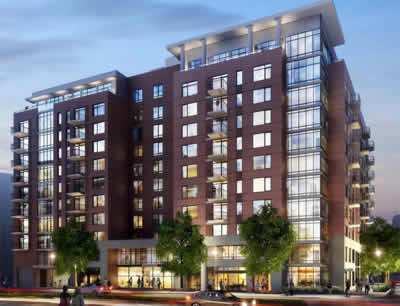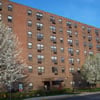
Freddie Mac (FHLMC) Multifamily Mortgages
A FHLMC mortgage is a type of multifamily loan that is secured by a first-position mortgage on a traditional, student housing, senior housing, or affordable housing property. These mortgages may be held in the FHLMC portfolio (10% of mortgages) or sold to bond investors (90% of mortgages).
The loan may be fixed or floating (which may or may not include an interest-only period) and is typically amortized over 25-30 years, with a balloon payment due at the end of the term unless it is a self-amortizing portfolio loan.
| Loan Type | Property Type * | Min Loan Amount | Max LTV | Term Length | Amortization | Rates |
| FHLMC | A, AH, MH, SH | $1,000,000 | 80% | 5-30 Years | 30 Years | |
| *A = Apartment AH = Affordable Housing MH = Manufactured Housing SH = Senior Housing | ||||||
| Additional Information: | Parameters | Loan Features | Prepayment Penalties | Securitization | Rating Agencies | Loan Servicing | ||||||
Programs & Underwriting Parameters
FHLMC has several different loan programs under which a Borrower may obtain a loan, so the investment strategy of the property must be heavily considered. The following are a list of Freddie Mac’s programs, along with a synopsis of the underwriting standards for each.
Program Plus
Fixed-Rate Loan: The fixed rate product may be used for the acquisition or refinance of all major multifamily project types. Typical loan amounts are $5-100 million and may include interest-only options. Maximum available LTV is 80% and minimum debt service coverage ratio is 1.25x.
Floating-Rate Loan: The fixed rate product may be used for the acquisition or refinance of all major multifamily project types except for cooperative housing. Typical loan amounts are $5-100 million and may include interest-only options. Maximum available LTV is 80% and minimum debt service coverage ratio is 1.25x.
Student Housing Mortgage: The student housing product is for the acquisition or refinance of purpose-built student housing with 12 month and parental guaranteed leases preferred. Residence halls or other multiple occupancy rooms with a shared common bathroom and centralized food service areas or dining halls do not qualify. Typical loan amounts are $5-100 million and may include interest-only options. Maximum available LTV is 80% and minimum debt service coverage ratio is 1.30x.
Lease-Up Loan: The lease-up product is for traditional multifamily properties only with substantially complete construction that is in need of stabilization; this is not available for student, senior, or affordable housing. Maximum leverage is a 75% LTV with a 1.30x debt service coverage ratio (with a letter of credit or reserve); otherwise, there is a max LTV of 65% and debt service coverage ratio of 1.25x.
Manufactured Housing Community Loan: The manufactured housing product is for existing, stabilized, high-quality, professionally managed manufactured housing communities (MHCs), with or without age restrictions. Loan amounts are $1 million+ and may include interest-only options. Maximum available LTV is 75% and minimum debt service coverage ratio is 1.25x.
Revolving Credit Facility: The revolving credit product is a 5 year secured line-of-credit on any of the major multifamily property types; borrower can move assets in and out of the facility for rehabilitation/upgrade, acquisition, or refinance. Typical loan amounts are $100 million+ and are interest-only. Maximum available LTV is 75% and minimum debt service coverage ratio is 1.45x.
Supplemental Loan: The supplemental loan product is for stabilized properties with Freddie Mac first lien mortgages in place. Loan amounts are $1 million+ and may include interest-only options. Maximum available LTV is 80% and minimum debt service coverage ratio is 1.25x.
Value-Add Loan: The value-add loan is an acquisition loan offering a short-term, cost-effective financing option for moderate property upgrades. It has a floating interest-only rate with an 80% max LTV and a debt service coverage ratio based on 7-year fixed rate at current pricing.
Targeted Affordable
9% LIHTC Cash Loan: This low income tax credit loan is for affordable multifamily complexes that have received 9% LIHTC. This can be structured as a forward commitment for new construction or substantial rehabilitation, financing for acquisition or refinance of stabilized properties, or financing for the moderate rehabilitation of the property. Maximum available LTV is 90% and minimum debt service coverage ratio is 1.15x. Terms may also go up to 35 years.
Bond Credit Enhancement with 4% LIHTC: This low income tax credit financing is for affordable multifamily complexes that have received 4% LIHTC. This can be structured as a forward commitment for new construction or substantial rehabilitation, financing for acquisition or refinance of stabilized properties, or financing for the moderate rehabilitation of the property. Maximum available LTV is 90% and minimum debt service coverage ratio is 1.15-1.20x. Terms may also go up to 35 years.
Bond Credit Enhancement with Other Affordability Components: This affordability financing is a credit enhancement program for fixed- or variable-rate multifamily housing bonds including bond refunding’s, substitutions, or new issue transactions with 80-20 bonds, combination bonds, 501(c)(3) bonds, Section 8, Section 236 or tax abatements. Maximum available LTV is 85% and minimum debt service coverage ratio is 1.25x. Terms may also go up to 30 years.
Cash Loan with Other Affordability Components: This affordable loan is financing for the acquisition or refinance of stabilized affordable multifamily properties (Section 8, Section 236, tax abatement or other) with fixed-rate or floating-rate cash mortgages. Maximum available LTV is 80% and minimum debt service coverage ratio is 1.25x. Terms may also go up to 30 years (unless HUD risk sharing is structured into the deal).
Direct Purchase of Tax-Exempt Mortgages: This affordability financing for the acquisition or refinance of affordable multifamily properties with 4% LIHTC with at least 7 years remaining in the initial LIHTC compliance period. Maximum available LTV is 90% and minimum debt service coverage ratio is 1.15x. Terms may also go up to 18 years and amortizations up to 35 years.
Preservation Rehabilitation Financing: This affordability loan product is financing for the moderate rehabilitation of affordable multifamily properties with new Low-Income Housing Tax Credits (LIHTC). Maximum available LTV is 90% and minimum debt service coverage ratio is 1.15x. Terms and amortizations up to 35 years.
Supplemental Loan: The supplemental loan product is for stabilized properties with Freddie Mac first lien mortgages in place. Loan amounts are $1 million+ and may include interest-only options. Maximum available LTV is 80% and minimum debt service coverage ratio is 1.25x.
Tax-Exempt Bond Securitization (TEBS): The TEBS product is a structure in which a Sponsor transfers privately placed tax-exempt multifamily housing revenue bonds (and possibly related taxable bonds or loans) to FHLMC in exchange for FHLMC senior Class-A M certificates that are sold to investors and Subordinate Class-B M Certificates that are retained by the Sponsor. Minimum pool size is $100 million and minimum debt service coverage ratio is 1.05x.
Variable Liquidity Pricing: This variable product offers variable liquidity pricing comprised of a fixed component for five years and a variable component that adjusts every 90 days with extension(s) available with repricing of the fixed component. This is for Targeted Affordable Housing (TAH) retail bond credit enhancement transactions involving immediate funding and funded forwards and Tax-Exempt Bond Securitization (TEBS) transactions. Maximum LTV is 80% with a 5 year liquidity contract duration and 10-30 year credit enhancement duration.
Seniors
Senior Housing Loan: This type of loan is for the acquisition or refinance of senior housing properties including: independent living communities, assisted living communities, skilled nursing or memory care facilities. Borrowers must have experience as an owner/operator of comparable facilities and meet ownership structure requirements. Rates can be floating or fixed, with the ability to advance rate lock.
Small Balance
Small Balance Loans: The Freddie Mac small balance program provides financing of small balance loans using hybrid ARM or fixed-rate loan products, offering partial-term and full-term interest-only. This program also features a streamlined process and competitive pricing. The loan amount for this program is $1 million to $5 million.
Freddie Mac Residential Portfolio Loans
Freddie Mac Single-Family Rental (SFR) Pilot Program: Seeing the need for a product that can provide a financing option for single family rental home portfolios, Freddie Mac is testing out a new loan product called the Single-Family Rental Pilot Program. .
Loan features
Term Length/Amortization: FHLMC loan terms are typically 5-10 years unless the mortgages are held in the Freddie Mac portfolio, in which case the terms may go up to 30 years. Amortizations may also go up to 30 years, but amortization depends heavily on the product selected as well as the condition and type of the property.
Recourse: Mortgages are always Non-Recourse, except for standard carve-out provisions. What this means is that the Borrowers are not personally liable for the repayment of the loan and that the collateralized property and its cash flows would be the sole source of repayment of the debt in the event of a foreclosure. However, in the event the Borrower actively participates in an activity that could cause harm to the property, Lender, or investors, there could be springing recourse in some limited circumstances; this may include loan fraud, property transfer or subordinate financing without consent of the Lender, voluntary or collusive activity leading to a bankruptcy filing or failure to maintain SPE status, among other such actions.
Rate Lock: Borrowers will lock the interest rate in advance of the loan closing, but the type of rate lock selected will depend on how far the Borrower will need it completed before closing. FHLMC offers four types of rate lock options in order to meet whatever the Borrower’s needs are.
Loan Assumption: FHLMC mortgages are assumable, but the new assuming borrower (i.e. Purchaser) must qualified by meeting the original underwriting standards. Typically this occurs when the Borrower wants to sell the commercial real estate that secures the loan, and the Purchaser of the property wants to take the loan over. Once the property sale and assumption is completed, the Purchaser becomes the owner of the property and is bound by the original terms of the assumed loan and the original Borrower/Seller is released from its obligation to the property and the existing loan. The benefit of this structure is that the assumption of the loan allows the Borrower/Seller to avoid defeasance or other pre-payment costs and give the buyer the opportunity to assume a loan that may have favorable terms than what is market. Loan assumption is an especially attractive option in high interest rate environments or tight credit environments. In an attempt to expedite FHLMC loan assumption, processes have been streamlined for Buyers and Sellers.
Prepayment Penalties
There are two prepayment penalty structures for fixed FHLMC mortgages – Yield Maintenance and Defeasance, and both include a 2 year lockout period. With a Yield Maintenance prepayment penalty, the loan is actually paid off and the mortgage note is cancelled, whereas a Defeasance is a substitution of one source of collateral (the property) with another (typically treasury bonds) which is then transferred to a special purpose entity (SPE) called a “Successor Borrower.” Both of the structures can cause the Borrower to incur significant monetary penalties if the loan is prepaid well before the maturity date or the US Treasury bonds fall substantially, so anticipated hold time and consideration of future markets should be taken into consideration when contemplating the term for this type of loan structure.
There are 4 prepayment penalty structures for floating FHLMC mortgages which include a flat 1% fee as well as 3 declining structures.
Yield Maintenance: Yield Maintenance. The goal of Yield Maintenance is to allow the bond investors to maintain the same yield as if the borrower made all scheduled mortgage payments until maturity. The penalty is typically calculated by a formula contained in the Note of the Loan Documents. The language will vary between different institutions, but will typically have the same two amounts to be repaid, namely: 1) The loan’s unpaid principal balance and 2) a prepayment penalty, which is typically determined by calculating the difference between the loan’s interest rate and the replacement rate (based on the US Treasury rate that most closely corresponds to the maturity date), with the remaining loan payments discounted back for the time value of money. One thing to keep in mind is that yield maintenance provisions usually contain a prepayment penalty “floor” of at least 1%.
Defeasance: With defeasance, the loan is not repaid and the note remains in place, but substitute collateral (typically in the form of bonds or other securities) is arranged by the defeasing firm and replaces the commercial real estate securing the loan so the property can be sold or refinanced. The cash flows generated from these new securities are in the form of coupons and maturing securities which will cover all future loan payments. When the average yield on the substitute collateral is higher than the loan, it is cheaper to purchase securities to cover the loan’s remaining principal and interested (P&I) payments. Unlike yield maintenance, defeasance provisions do not contain a floor. However, the third-party administrative fees in order to defease typically range from $50,000 to $100,000, depending on the loan’s size and complexity. For more specific detail, you may also review the Defeasance Rider to the loan documents.
Securitization/Loan Pools (K Deals)
After a loan is funded, it is put into a security pool of at least $1 billion which is sold to a bond issuer/depositor that puts the pool into a third party trust. This trust packages the pools into bonds, or “securitizes” the loans. FHLMC then purchases the senior, guaranteed bonds issued by the trust and securitizes them via the Freddie Mac Trust into K Certificates, which are guaranteed by Freddie Mac. These certificates are then sold on the open market to investors, which typically include life insurance companies, pension funds, money managers, mutual funds, and commercial banks for the investment grade pools. The subordinate and mezzanine bonds (which are not guaranteed by Freddie Mac) are sold to private investors by the third party trust. Investors choose which bonds or certificates to purchase based on the level of credit risk, yield, and duration that they seek.
Rating Agencies
FHLMC's mortgage securities are not rated separately by any of the main rating agencies (i.e Moodys, Standard & Poors, etc.). This is because they carry the implied AAA rating of Freddie Mac's Credit Rating and its reputation for default rates far below the rest of the industry.
Loan Servicing
The Freddie Mac lender or a third party may service the mortgages. The Master Servicer is responsible for day-to-day loan servicing practices including collecting loan payments, managing escrow accounts, analyzing financial statements inspecting collateral and reviewing borrower consent requests. All non-performing mortgages are usually sent to the special servicer. The special servicer is responsible for preforming customary work-out related duties including extending maturity dates, restructuring mortgages, appointing receivers, foreclosing the lender’s interest in a secured property, managing the foreclosed real estate and selling the real estate. Under some situations, master servicers subcontract some of their responsibilities to a primary or sub servicer in order to uphold the servicing standard when they need additional assistance. FHLMC is currently ranked above average for both master and special servicing.





